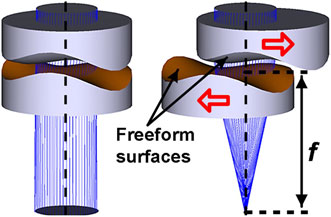An endoscopic probe with adjustable-focus capabilities in a slim package could facilitate more effective and less painful colonoscopies.
Researchers at the National University of Singapore (NUS) developed the instrument using prototypical solid tunable lens technology. Although this new device still is in its early stages and has not yet been tested in a clinical setting, it is less bulky than current high-magnification endoscopes.
It's a case of function following mechanical form, as current endoscope technology attempts to zoom in to the best of the camera's ability in order to reduce need to physically move the device. Physical movement is the root cause of discomfort experienced by patients during colonoscopies.

Two transparent polymer plates, each with a free-form curved surface, create a solid tunable lens. When the plates are perfectly aligned, they behave as one unit without any focusing power. When they are slightly offset, they refract light like a traditional lens. Courtesy of Optics Express.
The procedure has become routine for helping to catch colon cancer in its early stages. In addition, endoscopy is a key nonsurgical imaging technique that allows doctors to spot ulcers, polyps or bleeding inside the large intestines of patients safely and avoid complications that might result from exploratory surgery.
The new device's autofocusing capability allows it to switch from a wide field of view to a clear, close-up high-definition view without moving the endoscope probe.
"This may not only reduce the complexity of the endoscopic procedure but also allow potentially high-magnification endoscopy," said professor Guangya Zhou, the project’s lead investigator.
Some labs are testing an alternative approach to reducing the size of endoscopes by making them with tunable liquid crystal lenses, but the NUS researchers indicated that those lenses can be fragile and difficult to handle.
Their lens system contains two transparent polymer plates, each with one flat surface and one free-form curved surface. The free-form surfaces are opposites of each other. When the plates are perfectly aligned, they behave as one unit without any focusing power — any wave phase shift induced by one is cancelled out by the other. When they are slightly offset in a sideways direction, they refract light like a traditional lens.
Two piezoelectric benders drive these minute shifts in lens placement, controlling the focusing power of the endoscope by changing the degree of displacement. The image is then transmitted to an external camera that is monitored by a technician.
"It is the first time, to our knowledge, that a solid electrically tunable lens is implemented in an endoscopic system for the purpose of focus tuning," Zhou said.
The next step will be to incorporate multiple tunable lenses into the system so that it not only has adjustable focus but also full-fledged optical zooming capabilities.
The team’s findings were published Optics Express (doi: 10.1364/OE.23.020582).
For more information, visit www.nus.edu.sg.